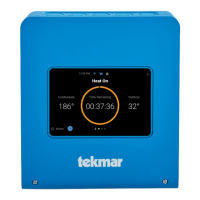9
Flue Sensor
An optional Flue Sensor 069 can be installed on the boiler flue to measure the flue gas temperature. It is not
possible to have both a flue sensor and an indoor sensor installed at the same time as they share the same
auxiliary sensor input.
• Connect the wires to the Aux sensor terminals 8 and 9.
FCC ID: 2AHQR-11500A
Contains FCC ID:
2AC7Z-ESP32WROOM32E
QOQMGM12P0
Contains IC ID:
21098-ESPWROOM32E
5123A-MGM12P0
CAN ICES-3 (A)/NMB-3(A)
Class 2 Circuits
Input Power:
115 V (ac) ±10%, 60 Hz, 4 W
Relays:
230 V (ac), 5 A, 1/3 hp
Calls:
24 V (ac) or Short
Operating Temperature:
32°F to 122°F (0°C to 50°C)
Use Copper Conductors Only
Wi-Fi: 802.11b/g/n, 2.4GHz
12
10/100
Ethernet
14
13
Boiler 1
Enable
1615
Boiler 2
Enable
1817
Comb
Air Relay
2019
Power
N
DANGER
To Reduce the Risk of Electric
Shock - Do not connect to a
circuit operating at more than
150 volts to ground.
Pour réduire les risques
d'électrocution choc - ne pas
raccorder à un circuit
fonctionnant à plus de 150 V à
la terre.
L
54
Outdoor
76
Cond
Sensor
98
Aux
Sensor
1110
DHW
231
Ref In Gnd
Pressure Sens
Call
+
Sensor
H2065A
Smart Steam Control 289
For product literature:
Pour la documentation
du produit:
tekmarControls.com
tektra 1150-02
Designed and assembled
in Canada
N
G
L
TT TT
Indoor Sensor
An optional Indoor Sensor 076, 077, or 084 can be installed to measure the ambient temperature in a hallway
or apartment unit. It is not possible to have both a flue sensor and an indoor sensor installed at the same time
as they share the same auxiliary sensor input.
• Connect the wires to the Aux sensor terminals 8 and 9.
FCC ID: 2AHQR-11500A
Contains FCC ID:
2AC7Z-ESP32WROOM32E
QOQMGM12P0
Contains IC ID:
21098-ESPWROOM32E
5123A-MGM12P0
CAN ICES-3 (A)/NMB-3(A)
Class 2 Circuits
Input Power:
115 V (ac) ±10%, 60 Hz, 4 W
Relays:
230 V (ac), 5 A, 1/3 hp
Calls:
24 V (ac) or Short
Operating Temperature:
32°F to 122°F (0°C to 50°C)
Use Copper Conductors Only
Wi-Fi: 802.11b/g/n, 2.4GHz
12
10/100
Ethernet
14
13
Boiler 1
Enable
1615
Boiler 2
Enable
1817
Comb
Air Relay
2019
Power
N
DANGERDANGER
To Reduce the Risk of Electric
Shock - Do not connect to a
circuit operating at more than
150 volts to ground.
Pour réduire les risques
d'électrocution choc - ne pas
raccorder à un circuit
fonctionnant à plus de 150 V à
la terre.
L
54
Outdoor
76
Cond
Sensor
98
Aux
Sensor
1110
DHW
231
Ref In Gnd
Pressure Sens
Call
+
Sensor
H2065A
Smart Steam Control 289
For product literature:
Pour la documentation
du produit:
tekmarControls.com
tektra 1150-02
Designed and assembled
in Canada
N
G
L
TT TT
L
NG
TEMPERATURE RESISTANCE TEMPERATURE RESISTANCE TEMPERATURE RESISTANCE TEMPERATURE RESISTANCE
°F °C
Ω
°F °C
Ω
°F °C
Ω
°F °C
Ω
-50 -46 490,813 20 -7 46,218 90 32 7,334 160 71 1,689
-45 -43 405,710 25 -4 39,913 95 35 6,532 165 74 1,538
-40 -40 336,606 30 -1 34,558 100 38 5,828 170 77 1,403
-35 -37 280,279 35 2 29,996 105 41 5,210 175 79 1,281
-30 -34 234,196 40 4 26,099 110 43 4,665 180 82 1,172
-25 -32 196,358 45 7 22,763 115 46 4,184 185 85 1,073
-20 -29 165,180 50 10 19,900 120 49 3,760 190 88 983
-15 -26 139,403 55 13 17,436 125 52 3,383 195 91 903
-10 -23 118,018 60 16 15,311 130 54 3,050 200 93 829
-5 -21 100,221 65 18 13,474 135 57 2,754 205 96 763
0 -18 85,362 70 21 11,883 140 60 2,490 210 99 703
5 -15 72,918 75 24 10,501 145 63 2,255 215 102 648
10 -12 62,465 80 27 9,299 150 66 2,045 220 104 598
15 -9 53,658 85 29 8,250 155 68 1,857 225 107 553
Testing the Sensor Wiring
A good quality test meter capable of measuring up to 5,000 kΩ
(1 kΩ = 1000 Ω) is required to measure the sensor resistance.
In addition to this, the actual temperature must be measured
with either a good quality digital thermometer, or if a thermom-
eter is not available, a second sensor can be placed alongside
the one to be tested and the readings compared.
First measure the temperature using the thermometer and
then measure the resistance of the sensor at the control.
The wires from the sensor must not be connected to the con-
trol while the test is performed. Using the chart below, estimate
the temperature measured by the sensor. The sensor and
thermometer readings should be close. If the test meter reads
a very high resistance, there may be a broken wire, a poor
wiring connection or a defective sensor. If the resistance is very
low, the wiring may be shorted, there may be moisture in the
sensor or the sensor may be defective. To test for a defective
sensor, measure the resistance directly at the sensor location.
Do not apply voltage to a sensor at any time as damage
to the sensor may result.
Call customer service if you need assistance with technical details.

